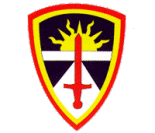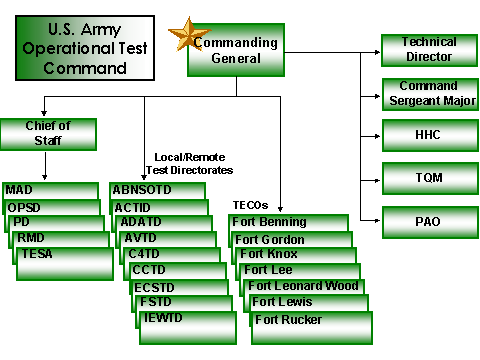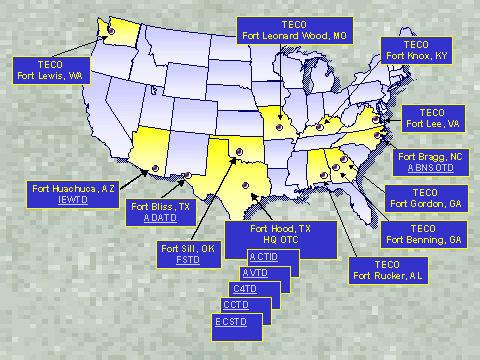Operational Test Command
 Operational Test Command [OTC] plans and conducts independent operational testing and experiments in order to provide essential information for the decision making process.
Operational Test Command [OTC] plans and conducts independent operational testing and experiments in order to provide essential information for the decision making process.
The humble beginnings of USAOTC began in the storeroom of the old III Corps conference room on October 1, 1969. A small group of military and civilian employees launched a unique test organization that has now spanned 30 years, evolving from MASSTER into the organization that it is today.
U.S. Army Project Mobile Army Sensor Systems Test, Evaluation and Review - MASSTER for short - was to be a temporary organization that, at most, would only last as long as the conflict in Vietnam. There was no fanfare or flags flying when MASSTER was established. But, under the command of the U.S. Continental Army Command, they had a mission "...to ensure development of an optimum battlefield intelligence gathering system as part of the Army's integrated area control system and provide for the evaluation of review of Army surveillance, target acquisition, and night observation matters." What the mission statement boiled down to was test and evaluation of a multitude of night observation and target acquisition devices in the Army and determine the best of each type system, along with some new ones as they were being developed.
The Army's recognition of the contributions made by Project MASSTER to the modernization of the Army through operational test and evaluation, which made maximum use of new technologies, resulted in the organization becoming permanent. In August 1970, Project MASSTER was redesignated Headquarters, Modem Army Selected Systems Test, Evaluation and Review - still MASSTER. In September 1971, MASSTER's charter was expanded to include test and evaluation of the tactical concepts of the Triple Capability (TRICAP) Division and Air Cavalry Combat Brigade (ACCB).
A major change occurred on July 1, 1974, when MASSTER was transferred from Forces Command to TRADOC. Shoulder sleeve insignia of military assigned to MASSTER changed from the III Corps to that of TRADOC. The practice of "dual-hatting" the III Corps commander as Commanding General, MASSTER, with the Deputy Commander in charge of MASSTER ended. Maj. Gen. Stewart C. Meyer became the first full Commander of MASSTER. The primary rationale was that TRADOC, which represents all of the Army's specialty schools and centers, should have its own test capability, particularly for what is called first development testing and experimentation.
1975 brought MASSTER back to its original purpose for activation as Project MASSTER in 1969. In the six years since concentrating on unattended ground sensors, technology had made some significant advances and MASSTER was back to sensor testing. This time it was highly sophisticated electronic equipment that was being considered for monitoring the new Middle East peace agreement in the Sinai desert.
On April 23, 1976, MASSTER was redesignated to TRADOC Combined Arms Test Activity (TCATA). With the redesignation came a 26-percent reduction in strength, down to 429. Meyer was still the commander at the time and stated that TCATA would continue to conduct large scale field tests of equipment, tactical concepts, and organizations.
Recognizing the need to streamline test activities within TRADOC, the TRADOC commander approved a concept in 1987, developed by Maj. Gen. Robert L. Drudik, TCATA commander, that would permit the task organization of test and experimentation resources. TRADOC Test and Experimentation Command (TEXCOM) was provisionally established on October 1, 1988. On December 11, 1988, CDEC was provisionally redesignated TEXCOM Experimentation Center (TEC), remaining at Fort Ord. The provisional TEXCOM headquarters was formed from the command and staff of TCATA, while the remaining three test directorates formed a new TEXCOM Combined Arms Test Center (TCATC). During the provisional year, the nine TRADOC test boards, located at the various TRADOC Training Centers and schools across the nation, were aligned under TEXCOM.
During 1990, TEXCOM went through one of the most significant and dramatic periods in its history - the consolidation of the Army's operational testing program. During that time, TEXCOM planned, executed, and reported some 100 operational tests. Major tests included Army Tactical Missile System, Line-of-Sight Forward Heavy System, Palletized Loading System, Light Assault Bridge, Vehicle Magnetic Signature Duplicator, and XM21 Remote Sensing Chemical Agent Alarm.
On its 30th Anniversary, TEXCOM was redesignated as U.S. Army Operational Test Command (OTC), a major subordinate command of U.S. Army Test and Evaluation Command (ATEC), Alexandria, Virginia.


|
NEWSLETTER
|
| Join the GlobalSecurity.org mailing list |
|
|
|

